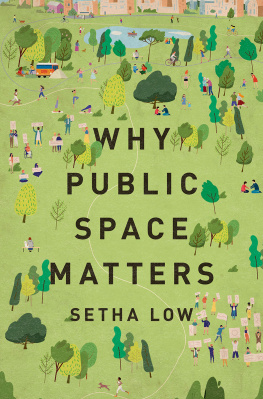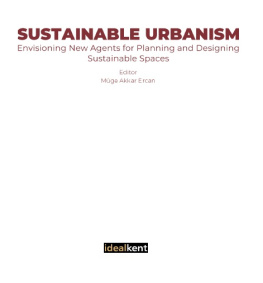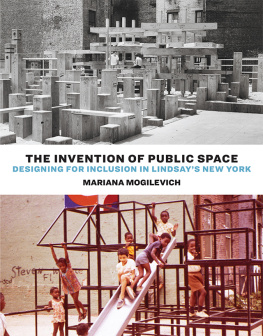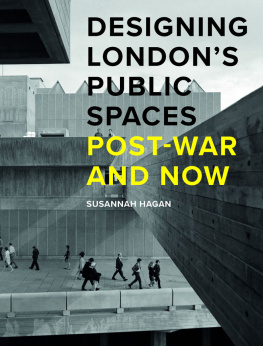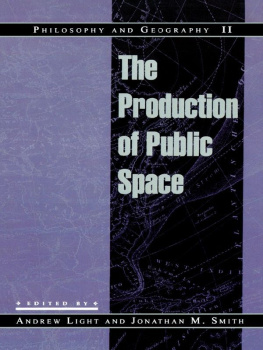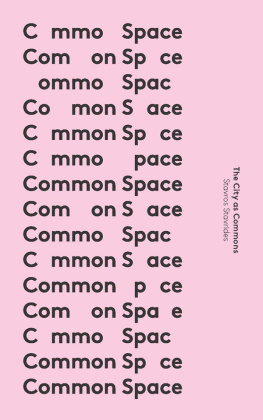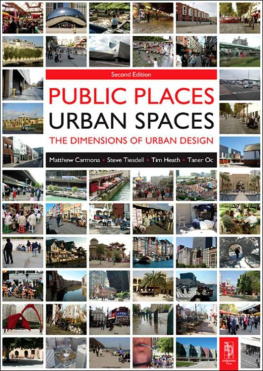WHY PUBLIC SPACE MATTERS

Oxford University Press is a department of the University of Oxford. It furthers the Universitys objective of excellence in research, scholarship, and education by publishing worldwide. Oxford is a registered trade mark of Oxford University Press in the UK and certain other countries.
Published in the United States of America by Oxford University Press
198 Madison Avenue, New York, NY 10016, United States of America.
Oxford University Press 2023
All rights reserved. No part of this publication may be reproduced, stored in a retrieval system, or transmitted, in any form or by any means, without the prior permission in writing of Oxford University Press, or as expressly permitted by law, by license, or under terms agreed with the appropriate reproduction rights organization. Inquiries concerning reproduction outside the scope of the above should be sent to the Rights Department, Oxford University Press, at the address above.
You must not circulate this work in any other form and you must impose this same condition on any acquirer.
CIP data is on file at the Library of Congress
ISBN 9780197543733
eISBN 9780197543757
DOI: 10.1093/oso/9780197543733.001.0001
For Gavin, Skye, and Max
who showed me the importance of public spaces for play, recreation, and creativity, and for all of us who need spaces to grow, learn, and explore
Contents
Table
Maps
Figures
This book grew out of a long journey to learn about and collect evidence on how public space contributes to socially just, equitable, and sustainable cities. Along the way many people and organizations funded, supported, and encouraged this endeavor. Many of the projects and ideas discussed have found their way into the scholarly literature, but here, I am responding to the call for action from UN Habitat, the New Urban Agenda, and colleagues around the world who are asking for research-based guidelines and a methodology to uncover inequalities and exclusionary practices. Javier Otero Pea encouraged the initial involvement with UN Habitat to find others committed to improving public space design and planning. Colleagues such as Michael Mehaffy of International Making Cities Livable; Laura Petrella, Jose Chong, and Cecilia Andersson of the Global Public Space Programme; Tigran Haas and Peter Elmlund of the Center for the Future of Places; Kristie Daniel of HealthBridge; Lance Brown of the Consortium for Sustainable Urbanization; Katherine Kline of the GAP on Aging; and Luisa Bravo of CitySpaceArchitecture have collaborated on this project to provide public space for all.
Conversations with Julian Agyeman, Jeff Hou, Matilde Cordoba, Suzanne Scheld, Dana Taplin, Jeff Maskovsky, Julian Brash, Ursula Rao, Shirley Strum, and John Jackson influenced many of the ideas presented. Monthly seminars of the Public Space Research Group (PSRG) co-organized with the Barcelona Lab for Urban Environmental Justice and Sustainability and Isabelle Anguelovski provided thoughtful discussions about these issues. Closer to home, graduate students (and now professors) Manissa Maharawal, Zoltan Gluck, Claire Panetta, Chris Baum, and Pengfei Li, and the current members of the Public Space Research GroupJavier Otero Pea, Evie Klein, Erin Lilli, Troy Simpson, Shokran Rahiminezhad, and Reilly Wilsoncontributed to my thinking. I am grateful to have had a lively scholarly community to accompany me on my intellectual travels. Many of you will recognize yourself and your work here, and I hope you are pleased with the results. Thank you for everything that you have contributed.
The Center for the Future of Places (CFP) directed by Tigran Haas at KTH in Stockholm and Peter Elmlund of the Ax:son Johnson Foundation invited me to present my ideas in 2014 at the second CFP conference in Buenos Aires. That was the beginning of several projects funded by the CFP that led to the creation of Tierra Publica, a public space database; the development of the Toolkit for the Ethnographic Study of Space (TESS); and funding to complete the research for this book. It was the comradery of my public space database co-creators, Vikas Mehta, David Brain, Peter Elmlund, and Michael Mehaffy, that sustained a focus on trying to figure out and communicate to a wider public why public space is so important. This book could not have been written without their financial and intellectual support.
The database project in New York was headed by Erin Lilli and Troy Simpson who took on conceptualizing the categories, defining the terms, and reviewing the literature in the fields of environmental psychology, anthropology, geography, and urban studies. They both contributed to the writing and testing of the TESS and moved the project forward. I want to particularly thank Erin, who has been my research assistant for the past three years. Erin was a co-presenter of the TESS at the World Urban Forum 10 in Abu Dhabi. Her insights into the chapters, the graphics, and general tone of the book were always valuable. During COVID-19 when I was often immersed in research or writing she kept the PSRG on track, as well as located books and articles in moments of desperation.
During the writing phase of this project, Joan Spivak, Javier Otero Pea, Shirley Strum, Susan Gooberman, Anna Harwin, Dana Taplin, Charles Price, Suzanne Scheld, Melissa Checker, Rodolfo Hernndez, Babette Audant, Chiara Martinuzzi, Mark Ojai, Andrew Newan, and Joel Lefkowitz came to the rescue by reading chapters and offering suggestions and constructive criticism. Melissa Checker suggested a developmental editor and found someone who was perfect. Andrew Newman, Mariano Perelman, Merrit Corrigan, Elisandro Garza, Greg Smithsimon, Susan Gooberman, Rodolfo Corchado, Bengi Sullu, Dana Taplin, and Suzanne Scheld not only read but carefully reviewed the sections that referenced their work to be sure that I got it right. Erin Lilli and Aurash Khawarzad conceptualized and created the graphics and Tompkins Square Park maps, while Greg Smithsimon, Mariano Perelman, Dana Taplin, Claire Panetta, Elisandro Garza, Andrew Newman, Joel Lefkowitz, and Merle Lefkowitz supplied photographs of the public space sites. I am indebted to these friends and colleagues for their intellectual, emotional, and substantive help.
While co-teaching landscape architecture and urban planning studios with Laurie Olin and the late Robert Hanna at the University of Pennsylvania, I learned that site surveys, circulation plans, social activity programs, and schematic designs are crucial components of imagining and creating public space. In planning and design studios and on design consulting projects they encouraged the use of ethnographic methods to produce better understandings of the role of the social and cultural as well as the architectural in creating places of opportunity rather than inequality. My colleagues at Pratt Institute, Ron Shiffman and David Burney, highlighted the importance of ethnographic understandings in the creation of a Place-Making program and gave me the opportunity to co-teach a Social Justice, Democracy, and Public Space semester that stimulated many of the ideas presented. I want to thank these dedicated colleagues for providing the opportunity to explore how ethnographic methods can make a difference in the analysis and design of public space and cities.
The ethnographic case studies presented in this book depended on the funding and teamwork of many people. I particularly would like to thank Erik Kulleseid, currently the commissioner of the Office of Parks, Recreation, and Historic Preservation for New York State, who funded the research at Lake Welch, Jones Beach, and Walkway Over the Hudson when he was head of the Alliance for New York State Parks. His enthusiasm was infectious, and we learned from his experience and commitment. I would also like to thank the National Park Service and especially Diana Pardue at the Statue of Liberty National Museum, Doris Fanelli at Independence National Historical Park, Richard Wells at Ellis Island, William Garrett at Jacob Riis Park, the late Muriel Crespi (PhD, past director of the National Park Service Applied Anthropology Program located in Washington D.C.), and Rebecca Joseph and Chuck Smythe (past East Coast regional directors of the ethnography program) for their support. Mitchell Silver, the New York City Department of Parks and Recreation commissioner from 20142022, inspired the research at Tompkins Square Park with his vision of Parks Without Borders. I would also like to thank the Graduate Center of the City University of New York and the Center for Human Environments for their assistance. Without Jared Beckers expertise as an administrator, these research projects would have been impossible to manage.

